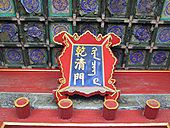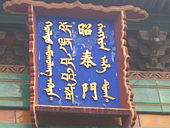Manchurian script
The Manchurian script is an adaptation of the Mongolian script for the language of the Manchu , a Tungusian language .
Examples
| Manchurian script (right) next to the Chinese script in the Forbidden City | Mongolian, Tibetan, Chinese and Manchurian script (far right), in the Lama Temple in Beijing | Manchurian script (far right) in the Chengde Summer Palace |
Writing direction
The Manchurian script, like the Mongolian script and traditional Chinese script, is written from top to bottom. The lines follow from left to right.
history
During the Qing Dynasty, the Manchurian script was the official script of the Chinese Empire alongside the Chinese script. Inscriptions in Manchurian can still be found in the Forbidden City today .
According to Manchurian tradition (ᠮᠠᠨᠵᡠ ᡳ
ᠶᠠᡵᡤᡳᠶᠠᠨ
ᡴᠣᡠᠯᡳ manju-i yargiyan kooli , Chinese : 滿洲 實錄 Mǎnzhōu Shílù) the Manchu leader Nurhaci decided in 1599 to adapt the Mongolian script for the language of the Manchu people. He regretted that uneducated Chinese or Mongols could understand their own language when it was read to them, whereas the Manchus, whose documents were recorded by Mongolian scribes, could not. The resulting script was called tongki fuka akū hergen ("script without points and circles").
It was not until 1632 that Dahai added diacritical marks to remove the many ambiguities in the Mongolian script.
alphabet
Syllables
The Manchurian script has 131 syllables :
| ᠠ a | ᡝ e | ᡳ i | ᠣ O | ᡠ u | ᡡ ū | ᠨᠠ n / A | ᠨᡝ no | ᠨᡳ ni | ᠨᠣ no | ᠨᡠ nu | ᠨᡡ nū | ||
| ᡴᠠ ka | ᡤᠠ ga | ᡥᠠ Ha | ᡴᠣ ko | ᡤᠣ go | ᡥᠣ ho | ᡴᡡ kū | ᡤᡡ gū | ᡥᡡ hu | |||||
| ᠪᠠ ba | ᠪᡝ be | ᠪᡳ bi | ᠪᠣ bo | ᠪᡠ bu | ᠪᡡ bū | ᡦᠠ pa | ᡦᡝ pe | ᡦᡳ pi | ᡦᠣ po | ᡦᡠ pu | ᡦᡡ pū | ||
| ᠰᠠ sa | ᠰᡝ se | ᠰᡳ si | ᠰᠣ so | ᠰᡠ see below | ᠰᡡ sū | ᡧᠠ ūa | ᡧᡝ še | ᡧᡳ ši | ᡧᠣ so | ᡧᡠ šu | ᡧᡡ šū | ||
| ᡨᠠ ta | ᡩᠠ there | ᡨᡝ te | ᡩᡝ de | ᡨᡳ ti | ᡩᡳ di | ᡨᠣ to | ᡩᠣ do | ᡨᡠ do | ᡩᡠ you | ||||
| ᠯᠠ la | ᠯᡝ le | ᠯᡳ left | ᠯᠣ lo | ᠯᡠ lu | ᠯᡡ lū | ᠮᠠ ma | ᠮᡝ me | ᠮᡳ mi | ᠮᠣ mo | ᠮᡠ must | ᠮᡡ mū | ||
| ᠴᠠ approx | ᠴᡝ ce | ᠴᡳ ci | ᠴᠣ co | ᠴᡠ cu | ᠴᡡ cū | ᠵᠠ Yes | ᠵᡝ ever | ᠵᡳ ji | ᠵᠣ jo | ᠵᡠ ju | ᠵᡡ jū | ||
| ᠶᠠ ya | ᠶᡝ ye | ᠶᠣ yo | ᠶᡠ yu | ᠶᡡ yū | ᡴᡝ ke | ᡤᡝ ge | ᡥᡝ hey | ᡴᡳ ki | ᡤᡳ gi | ᡥᡳ Hi | ᡴᡠ ku | ᡤᡠ gu | ᡥᡠ hu |
| ᠺᠠ k'a | ᡬᠠ g'a | ᡭᠠ Ha | ᠺᠣ k'o | ᡬᠣ g'o | ᡭᠣ h'o | ᡵᠠ ra | ᡵᡝ re | ᡵᡳ ri | ᡵᠣ ro | ᡵᡠ ru | ᡵᡡ rū | ||
| ᡶᠠ fa | ᡶᡝ fe | ᡶᡳ fi | ᡶᠣ fo | ᡶᡠ fu | ᡶᡡ fū | ᠸᠠ wa | ᠸᡝ we | ||||||
| ᡮᠠ ts'a | ᡮᡝ ts'e | ᡮᡟ ts | ᡮᠣ ts'o | ᡮᡠ ts'u | ᡯᠠ dza | ᡯᡝ dze | ᡯᡳ dzi | ᡯᠣ dzo | ᡯᡠ dzu | ||||
| ᡰᠠ ža | ᡰᡝ že | ᡰᡳ ži | ᡰᠣ žo | ᡰᡠ to | ᠰᡟ sy | ᡱᡳ c'y | ᡷᡳ jy |
literature
- Florian Coulmas : The Blackwell Encyclopedia of Writing Systems. Blackwell, 1999, ISBN 0-631-21481-X .



